Lin Cao
Multi-view Normal and Distance Guidance Gaussian Splatting for Surface Reconstruction
Aug 13, 2025Abstract:3D Gaussian Splatting (3DGS) achieves remarkable results in the field of surface reconstruction. However, when Gaussian normal vectors are aligned within the single-view projection plane, while the geometry appears reasonable in the current view, biases may emerge upon switching to nearby views. To address the distance and global matching challenges in multi-view scenes, we design multi-view normal and distance-guided Gaussian splatting. This method achieves geometric depth unification and high-accuracy reconstruction by constraining nearby depth maps and aligning 3D normals. Specifically, for the reconstruction of small indoor and outdoor scenes, we propose a multi-view distance reprojection regularization module that achieves multi-view Gaussian alignment by computing the distance loss between two nearby views and the same Gaussian surface. Additionally, we develop a multi-view normal enhancement module, which ensures consistency across views by matching the normals of pixel points in nearby views and calculating the loss. Extensive experimental results demonstrate that our method outperforms the baseline in both quantitative and qualitative evaluations, significantly enhancing the surface reconstruction capability of 3DGS. Our code will be made publicly available at (https://github.com/Bistu3DV/MND-GS/).
STF-GCN: A Multi-Domain Graph Convolution Network Method for Automatic Modulation Recognition via Adaptive Correlation
Apr 11, 2025Abstract:Automatic Modulation Recognition (AMR) is an essential part of Intelligent Transportation System (ITS) dynamic spectrum allocation. However, current deep learning-based AMR (DL-AMR) methods are challenged to extract discriminative and robust features at low signal-to-noise ratios (SNRs), where the representation of modulation symbols is highly interfered by noise. Furthermore, current research on GNN methods for AMR tasks generally suffers from issues related to graph structure construction and computational complexity. In this paper, we propose a Spatial-Temporal-Frequency Graph Convolution Network (STF-GCN) framework, with the temporal domain as the anchor point, to fuse spatial and frequency domain features embedded in the graph structure nodes. On this basis, an adaptive correlation-based adjacency matrix construction method is proposed, which significantly enhances the graph structure's capacity to aggregate local information into individual nodes. In addition, a PoolGAT layer is proposed to coarsen and compress the global key features of the graph, significantly reducing the computational complexity. The results of the experiments confirm that STF-GCN is able to achieve recognition performance far beyond the state-of-the-art DL-AMR algorithms, with overall accuracies of 64.35%, 66.04% and 70.95% on the RML2016.10a, RML2016.10b and RML22 datasets, respectively. Furthermore, the average recognition accuracies under low SNR conditions from -14dB to 0dB outperform the state-of-the-art (SOTA) models by 1.20%, 1.95% and 1.83%, respectively.
Design and Prototyping of Filtering Active STAR-RIS with Adjustable Power Splitting
Jan 19, 2025



Abstract:Reconfigurable Intelligent Surfaces (RISs) have emerged as a transformative technology for next-generation wireless communication systems, offering unprecedented control over electromagnetic wave propagation. In particular, Simultaneously Transmitting and Reflecting RISs (STAR-RISs) have garnered significant attention due to their full-space coverage. This paper presents an active STAR-RIS, which enables independent control of both transmission and reflection phases and features out-of-band harmonic suppression. Unlike the traditional passive RIS, the proposed design integrates active amplification to overcome the inherent passive losses, significantly enhancing signal strength and system performance. Additionally, the system supports dynamic power allocation between transmission and reflection modes, providing greater flexibility to meet diverse communication demands in complex propagation environments. The versatility of the design is further validated by extending the Radar Cross Section (RCS)-based path loss model to the STAR-RIS. This design improves efficiency, flexibility, and adaptability, offering a promising solution for future wireless communication systems, particularly in scenarios requiring simultaneous control of transmission and reflection signals.
Hybrid bundle-adjusting 3D Gaussians for view consistent rendering with pose optimization
Oct 17, 2024Abstract:Novel view synthesis has made significant progress in the field of 3D computer vision. However, the rendering of view-consistent novel views from imperfect camera poses remains challenging. In this paper, we introduce a hybrid bundle-adjusting 3D Gaussians model that enables view-consistent rendering with pose optimization. This model jointly extract image-based and neural 3D representations to simultaneously generate view-consistent images and camera poses within forward-facing scenes. The effective of our model is demonstrated through extensive experiments conducted on both real and synthetic datasets. These experiments clearly illustrate that our model can effectively optimize neural scene representations while simultaneously resolving significant camera pose misalignments. The source code is available at https://github.com/Bistu3DV/hybridBA.
Adaptable, shape-conforming robotic endoscope
Sep 14, 2024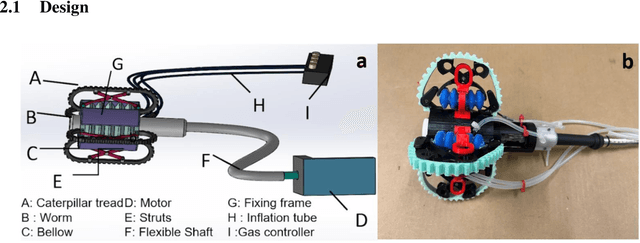
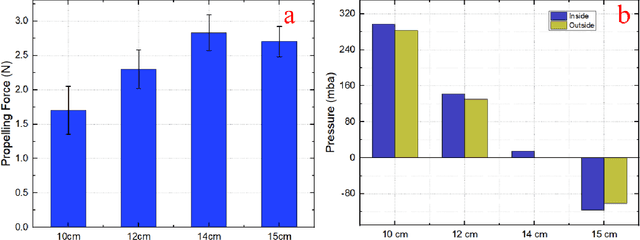
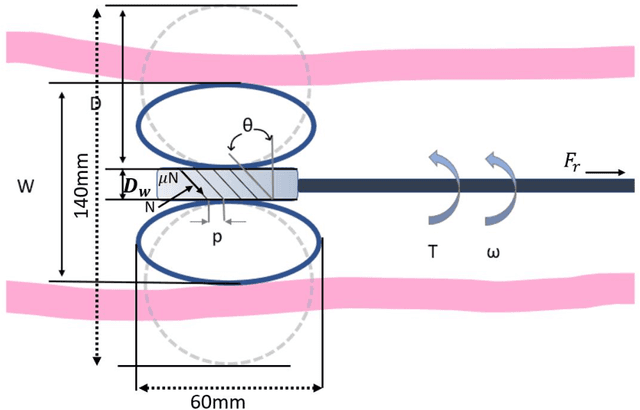
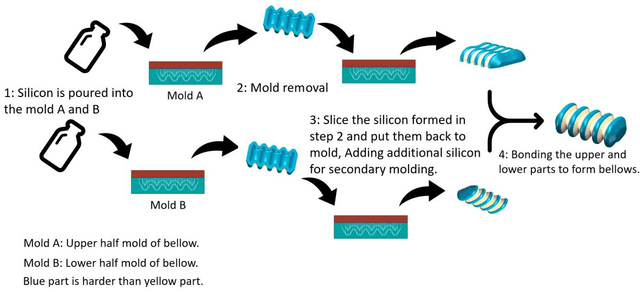
Abstract:This paper introduces a size-adaptable robotic endoscope design, which aims to improve the efficiency and comfort of colonoscopy. The robotic endoscope proposed in this paper combines the expansion mechanism and the external drive system, which can adjust the shape according to the different pipe diameters, thus improving the stability and propulsion force during propulsion. As an actuator in the expansion mechanism, flexible bellows can provide a normal force of 3.89 N and an axial deformation of nearly 10mm at the maximum pressure, with a 53% expansion rate in the size of expandable tip. In the test of the locomotion performance of the prototype, we obtained the relationship with the propelling of the prototype by changing the friction coefficient of the pipe and the motor angular velocity. In the experiment with artificial bowel tissues, the prototype can generate a propelling force of 2.83 N, and the maximum linear speed is 29.29 m/s in average, and could produce effective propulsion when it passes through different pipe sizes. The results show that the prototype can realize the ability of shape adaptation in order to obtain more propulsion. The relationship between propelling force and traction force, structural optimization and miniaturization still need further exploration.
Prototyping and real-world field trials of RIS-aided wireless communications
Aug 07, 2023



Abstract:Reconfigurable intelligent surface (RIS) is a promising technology that has the potential to change the way we interact with the wireless propagating environment. In this paper, we design and fabricate an RIS system that can be used in the fifth generation (5G) mobile communication networks. We also propose a practical two-step spatial-oversampling codebook algorithm for the beamforming of RIS, which is based on the spatial structure of the wireless channel. This algorithm has much lower complexity compared to the two-dimensional full-space searching-based codebook, yet with only negligible performance loss. Then, a series of experiments are conducted with the fabricated RIS systems, covering the office, corridor, and outdoor environments, in order to verified the effectiveness of RIS in both laboratory and current 5G commercial networks. In the office and corridor scenarios, the 5.8 GHz RIS provided a 10-20 dB power gain at the receiver. In the outdoor test, over 35 dB power gain was observed with RIS compared to the non-deployment case. However, in commercial 5G networks, the 2.6 GHz RIS improved indoor signal strength by only 4-7 dB. The experimental results indicate that RIS achieves higher power gain when transceivers are equipped with directional antennas instead of omni-directional antennas.
RIS with insufficient phase shifting capability: Modeling, beamforming, and experimental validations
Jul 05, 2023Abstract:Most research works on reconfigurable intelligent surfaces (RIS) rely on idealized model of the reflection coefficients, i.e., uniform reflection amplitude for any phases and sufficient phase shifting capability. In practice however, such models are oversimplified. This paper introduces a realistic reflection coefficient model for RIS based on measurements. The reflection coefficients are modeled as discrete complex values that have non-uniform amplitudes and suffer from insufficient phase shift capability. We then propose a group-based query algorithm that takes the imperfect coefficients into consideration while calculating the reflection coefficients. We analyze the performance of the proposed algorithm, and derive the closed-form expressions to characterize the received power of an RIS-aided wireless communication system. The performance gains of the proposed algorithm are confirmed in simulations. Furthermore, we validate the proposed theoretical results by experiments with our fabricated RIS prototype systems. The simulation and measurement results match well with the theoretical analysis.
RIS-aided Wireless Communications: Can RIS Beat Metal Plate?
Mar 06, 2023Abstract:Reconfigurable Intelligent Surface (RIS) has recently been regarded as a paradigm-shifting technology beyond 5G, for its flexibility on smartly adjusting the response to the impinging electromagnetic (EM) waves. Usually, RIS can be implemented by properly reconfiguring the adjustable parameters of each RIS unit to align the signal phase on the receiver side. And it is believed that the phase alignment can be also mechanically achieved by a metal plate with the same physical size. However, we found in the prototype experiments that, a well-rotated metal plate can only approximately perform as well as RIS under limited conditions, although its scattering efficiency is relatively higher. When it comes to the case of spherical wave impinging, RIS outperforms the metal plate even beyond the receiving near-field regions. We analyze this phenomenon with wave optics theory and propose explicit scattering models for both the metal plate and RIS in general scenarios. Finally, the models are validated by simulations and field measurements.
Information fusion approach for biomass estimation in a plateau mountainous forest using a synergistic system comprising UAS-based digital camera and LiDAR
Apr 14, 2022



Abstract:Forest land plays a vital role in global climate, ecosystems, farming and human living environments. Therefore, forest biomass estimation methods are necessary to monitor changes in the forest structure and function, which are key data in natural resources research. Although accurate forest biomass measurements are important in forest inventory and assessments, high-density measurements that involve airborne light detection and ranging (LiDAR) at a low flight height in large mountainous areas are highly expensive. The objective of this study was to quantify the aboveground biomass (AGB) of a plateau mountainous forest reserve using a system that synergistically combines an unmanned aircraft system (UAS)-based digital aerial camera and LiDAR to leverage their complementary advantages. In this study, we utilized digital aerial photogrammetry (DAP), which has the unique advantages of speed, high spatial resolution, and low cost, to compensate for the deficiency of forestry inventory using UAS-based LiDAR that requires terrain-following flight for high-resolution data acquisition. Combined with the sparse LiDAR points acquired by using a high-altitude and high-speed UAS for terrain extraction, dense normalized DAP point clouds can be obtained to produce an accurate and high-resolution canopy height model (CHM). Based on the CHM and spectral attributes obtained from multispectral images, we estimated and mapped the AGB of the region of interest with considerable cost efficiency. Our study supports the development of predictive models for large-scale wall-to-wall AGB mapping by leveraging the complementarity between DAP and LiDAR measurements. This work also reveals the potential of utilizing a UAS-based digital camera and LiDAR synergistically in a plateau mountainous forest area.
A Three-limb Teleoperated Robotic System with Foot Control for Flexible Endoscopic Surgery
Jul 12, 2020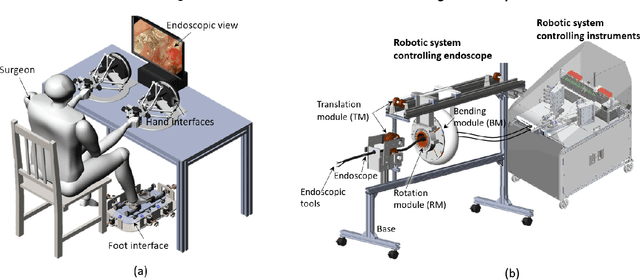
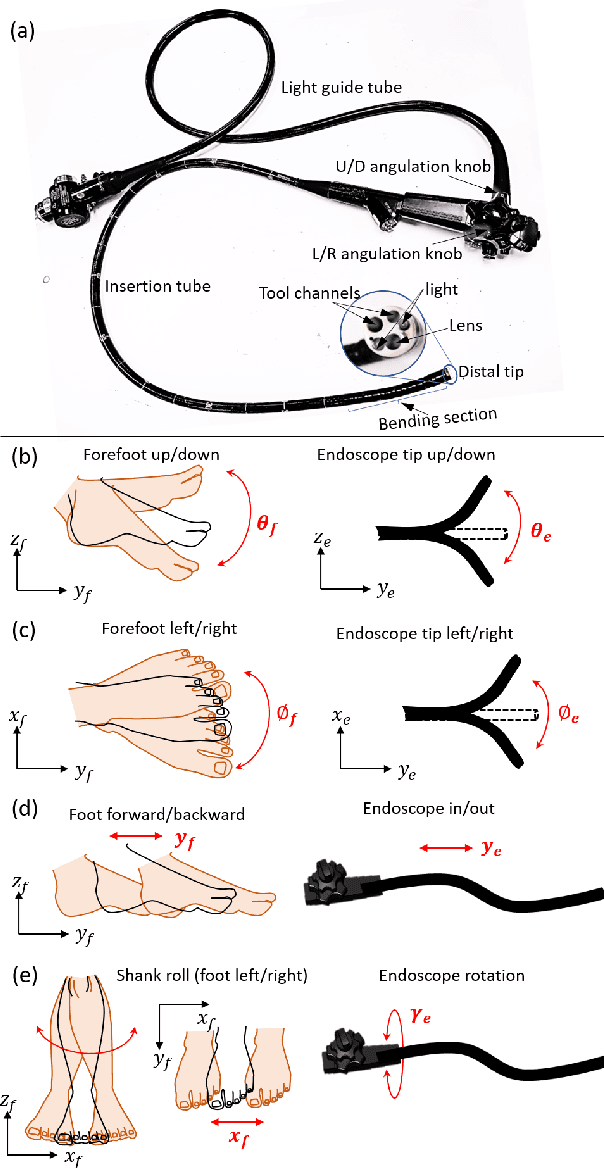
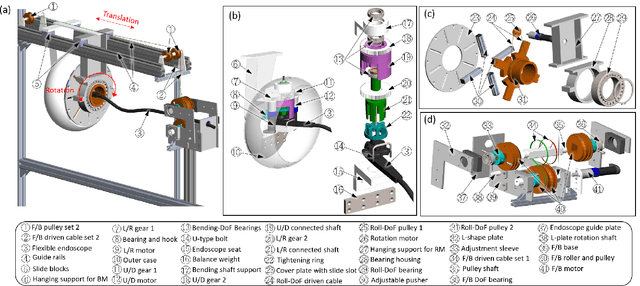
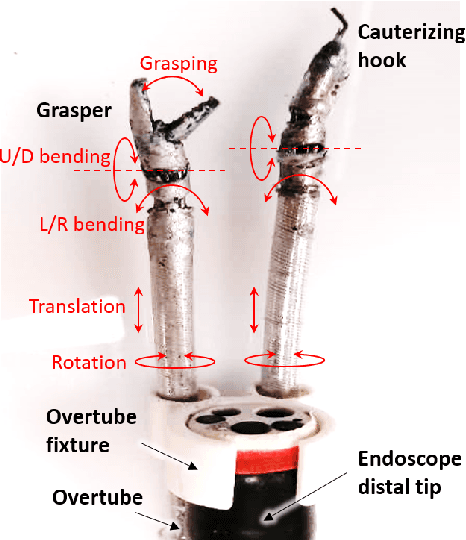
Abstract:Flexible endoscopy requires high skills to manipulate both the endoscope and associated instruments. In most robotic flexible endoscopic systems, the endoscope and instruments are controlled separately by two operators, which may result in communication errors and inefficient operation. We present a novel teleoperation robotic endoscopic system that can be commanded by a surgeon alone. This 13 degrees-of-freedom (DoF) system integrates a foot-controlled robotic flexible endoscope and two hand-controlled robotic endoscopic instruments (a robotic grasper and a robotic cauterizing hook). A foot-controlled human-machine interface maps the natural foot gestures to the 4-DoF movements of the endoscope, and two hand-controlled interfaces map the movements of the two hands to the two instruments individually. The proposed robotic system was validated in an ex-vivo experiment carried out by six subjects, where foot control was also compared with a sequential clutch-based hand control scheme. The participants could successfully teleoperate the endoscope and the two instruments to cut the tissues at scattered target areas in a porcine stomach. Foot control yielded 43.7% faster task completion and required less mental effort as compared to the clutch-based hand control scheme. The system introduced in this paper is intuitive for three-limb manipulation even for operators without experience of handling the endoscope and robotic instruments. This three-limb teleoperated robotic system enables one surgeon to intuitively control three endoscopic tools which normally require two operators, leading to reduced manpower, less communication errors, and improved efficiency.
 Add to Chrome
Add to Chrome Add to Firefox
Add to Firefox Add to Edge
Add to Edge